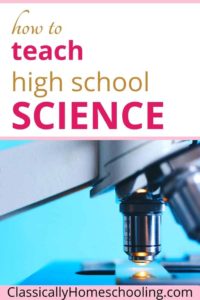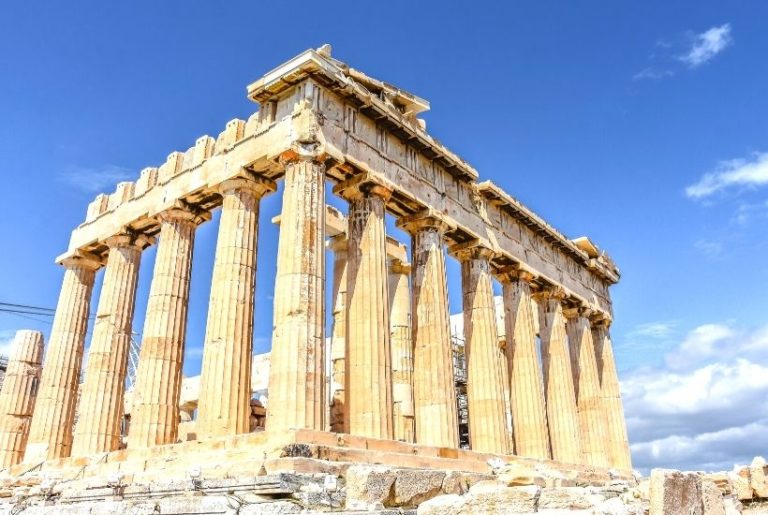How to Teach Classical High School Science
This post may contain affiliate links. For more information, please read my disclosure policy.
What is the goal of classical high school science?
Is it to teach the principles of studying the disciplines?
Teach a student how to conduct research in a lab and to write lab reports?
Perhaps to join in the great conversation of scientific discovery?
The answer is, all three!
1. teach the basic principles of science
The easiest method is to choose one of the three disciplines to cover each year.
Traditionally biology is covered first as it requires no math. Chemistry is second as it requires algebra, and physics is third.
Once you’ve picked the discipline for the year, choose a spine or textbook that will cover the basic principles of, say, biology.
There are several methods of studying the scientific spine.
One is to outline the book as the student works through it. Another is to read a section and to write a summary of the information.
My favorite is to have the student take general notes as they work through the chapter over a week.
The next week the student writes a 2-3 page paper over a topic of interest from the chapter.
The reading, note-taking, and writing cement the principles into the student’s brain.
2. teach the scientific method in regards to research
This means labs. Many textbooks will include labs in the textbook, but the spine you might have chosen may not have labs included.
In this case, find a book on science projects such as Janice VanCleave’s A+ Projects in Biology: Winning Experiments for Science Fairs and Extra Credit.
For science equipment, I recommend Home Science Tools.
Once the experiments are completed there is the question of writing a lab report.
Donna Young has a good collection of lab report worksheets to teach the basics of what is involved in writing lab reports.
These worksheets include spaces for the hypothesis, supplies, procedure and observations, results, analysis, and conclusion.
There are several styles of worksheets so you can find the one that fits your family the best.
3. join in the great scientific conversation

The best way to begin is to choose a scientific publication to read, contemplate, and write an evaluation of it.
Options for appropriate texts range from Aristotle’s Physics to Ray Kurzweil’s The Singularity is Near: When Humans Transcend Biology.
To complete the third goal of joining in the great scientific conversation, the student should also write a paper.
They can discuss a discovery or invention they find interesting and appropriate to the year’s study.
This should be a longer research paper that is completed over the course of several weeks or during the final quarter of the year.
These three goals of the classical high school science work together to produce a cohesive course.
The student studies the spine and completes lab work for the first 6-7 weeks of the quarter.
Then the high school student spends 2-3 weeks reading and summarizing a text on scientific thought.
Do this for the first 3 quarters of the school year. By this point, the student should have decided what discovery or invention they’d like to study.
During the first 6-7 weeks of the fourth quarter finish studying the spine while taking notes for the paper on a scientific discovery or invention.
Spend the last weeks of the school year writing and revising the paper.
By the end of the year, the student will have studied the basic principles of a scientific discipline.
They’ll have completed lab work, written lab reports, and joined in the great scientific conversation.
It may be daunting, but it is doable if you take teaching classical high school science week by week and step by step.
Are you teaching classical high school science this year?









Great summary of the goals of High School Science! I feel very far from high school, but I know it will creep up on me quickly =)
You make some great points about taking Science in a step-by-step model. This has worked well for us too, especially when we include a fair amount of hands on with all the reading and research. Thanks for your post 🙂
The step-by-step model has worked well for us through the years. I do best with large tasks broken down into small doable chunks. Thanks for stopping by. 🙂
You have some great ideas and I really appreciate you sharing them at Good Morning Mondays. Blessings
Thanks, Terri! 🙂
Instead of physics, we’ve chosen to do high school anatomy, because one of my sons loved biology so much that he wants to be a microbiologist.
Being able to be flexible and follow our kids interests is a great part of homeschooling! I’m seriously considering having one of my children, who’s also interested in biology, do marine biology instead of physics as well. 🙂
Homeschooling in high school isn’t easy, but it isn’t as hard as most people think, either. Posts like this one really help.
Thanks, Linda Sue! 🙂